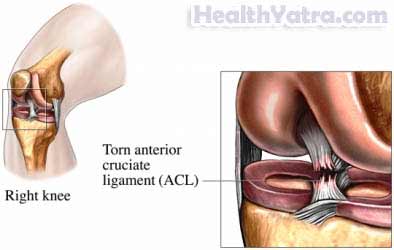Definition
An anterior cruciate ligament (ACL) injury is a tear in the ACL ligament. The ACL is located in the middle of the knee joint. It connects the lower leg bone to the thigh bone. It stabilizes the knee and prevents the lower leg bone from sliding too far forward at the knee.
The ACL ligament can become strained or torn when a strong force is applied to it. This can happen during sports or other high-stress activity.
Treatment depends on the severity of the injury.

Causes
ACL injury occurs when your knee gets twisted or during a hard landing from a jump. It can also happen with:
- Sudden stops or changes in direction
- Sidestepping or pivoting
- Direct contact
Risk Factors
ACL injuries are more common in women. Other factors that increase your chance of ACL injury include:
- Weak knee structure
- Muscle strength imbalance between the quadriceps and hamstrings
- Playing sports that require sudden changes of direction and deceleration
- Use of incorrect technique for cutting, planting, pivoting, or jumping
Symptoms
Symptoms may include:
- A popping sound at the time of the injury
- Pain and swelling in the knee
- Loss of full range of motion
- Weakness or instability in the knee
- Difficulty walking
Diagnosis
The doctor will ask about your symptoms and how you injured your knee. A physical exam will be done.
Tests may include:
- X-ray
- MRI
- Arthroscopy—a thin, lighted tube inserted through a small incision in the knee to look at the structures inside the knee
Ligament sprains are graded according to their severity:
- Grade 1—Mild ligament damage.
- Grade 2—Partial tearing of the ligament.
- Grade 3—Complete tearing of the ligament.
Treatment
Talk with your doctor about the best treatment plan for you. Recovery time ranges depending on the grade of your injury. Treatment steps may include:
Acute Care
Rest
Your ligament will need time to heal. Avoid activities that place extra stress on the knee:
- Do not do activities that cause pain. This includes running, jumping, and weight lifting using the legs.
- Do not play sports until your doctor has said it is safe to do so.
Your doctor may recommend a knee brace to stabilize the knee, and crutches to keep extra weight off your leg.
Cold
Apply an ice or a cold pack to the area for 15-20 minutes, four times a day, for several days after the injury. Do not apply the ice directly to your skin. Wrap the ice or cold pack in a towel.
Pain Relief Medications
To manage pain, your doctor may recommend:
- Over-the-counter medication, such as aspirin, ibuprofen, or acetaminophen
- Topical pain medication—creams or patches that are applied to the skin
- Prescription pain relievers
Compression
Compression can help prevent more swelling. Your doctor may recommend an elastic compression bandage around your knee. Be careful not to wrap the bandage too tight.
Elevation
Elevation can also help keep swelling down. Keep your knee higher than your heart as much as possible for the first 24 hours or so. A couple of days of elevation might be recommended for severe sprains.
Recovery Steps
Heat
Use heat only when you are returning to physical activity. Heat may then be used before stretching or getting ready to play sports to help loosen the ligament.
Stretching
When the acute pain is gone, start gentle stretching as recommended. Stay within pain limits. Hold each stretch for about 10 seconds and repeat six times. Stretch several times a day.
Strengthening
Begin strengthening exercises for your ligaments as recommended.
If you are diagnosed with a ACL injury, follow your doctor’s instructions.
Surgery
Surgery may be needed to fully restore function of the knee. The decision to have surgery should be made after discussion with your doctor about your athletic needs, age, and associated factors.
Prevention
To reduce your chance of injuring the ACL, take these steps:
- Plyometrics, a form of jumping exercises, can be used to train and strengthen the leg muscles for jumping and landing.
- When jumping and landing, or turning and pivoting, your hips and knees should be bent, not straight.
- Strengthen both the quadriceps and the hamstrings.
- Maintain proper technique when exercising or playing sports.
Anterior Cruciate Ligament Injury Treatment in India – Page Keywords:
Anterior Cruciate Ligament Injury Definition, Anterior Cruciate Ligament Injury Definition Causes, Anterior Cruciate Ligament Injury Symptoms, Anterior Cruciate Ligament Injury Treatment in India, Anterior Cruciate Ligament Injury Treatment Cost in India, Anterior Cruciate Ligament Injury Surgery Cost, Top Anterior Cruciate Ligament Injury Treatment Hospital, Top Anterior Cruciate Ligament Injury Treatment Doctor in India, Anterior Cruciate Ligament Injury Meaning in Marathi, Anterior Cruciate Ligament Injury Treatment Near me, Anterior Cruciate Ligament Injury Complications, Travel India for Anterior Cruciate Ligament Injury Treatment, Anterior Cruciate Ligament Injury Treatment in Arab Countries, Anterior Cruciate Ligament Injury Treatment in Bangladesh, Anterior Cruciate Ligament Injury Treatment in Dhaka, Anterior Cruciate Ligament Injury Meaning in Bengali, Anterior Cruciate Ligament Injury Meaning in Arabic, Anterior Cruciate Ligament Injury Meaning in Hindi, Anterior Cruciate Ligament Injury Treatment in Bahrain, Anterior Cruciate Ligament Injury Treatment in Egypt, Anterior Cruciate Ligament Injury Treatment in Iraq, Anterior Cruciate Ligament Injury Treatment in Jordan, Anterior Cruciate Ligament Injury Treatment in Kuwait, Anterior Cruciate Ligament Injury Treatment in Lebanon, Anterior Cruciate Ligament Injury Treatment in Saudi Arabia, Anterior Cruciate Ligament Injury Treatment in United Arab Emirates, Anterior Cruciate Ligament Injury Treatment in Sudan, Anterior Cruciate Ligament Injury Treatment in Tunisia, Anterior Cruciate Ligament Injury Treatment in Nepal, Anterior Cruciate Ligament Injury Treatment cost,
